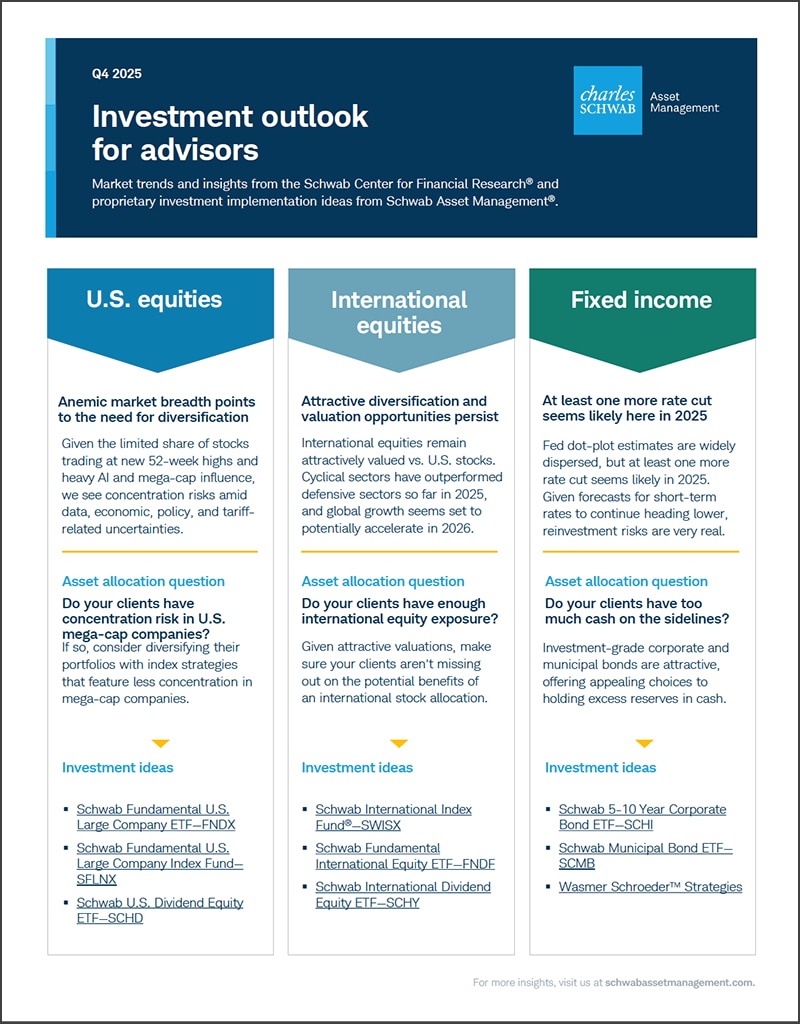Q4 Investment outlook for advisors
With the Fed cutting rates, the job market softening, inflation sticky, and market breadth anemic, there’s a lot to track. Get our latest insights to help you position clients for success.

Market trends and insights for advisors
Stay up-to-date on the latest market trends and investment ideas to help position clients for long-term success.
Anemic market breadth points to the need for diversification
Given the limited share of stocks trading at new 52-week highs and heavy AI and mega-cap influence, we see concentration risks amid data, economic, policy, and tariff-related uncertainties.

Attractive diversification and valuation opportunities persist
International equities remain attractively valued vs. U.S. stocks. Cyclical sectors have outperformed defensive sectors so far in 2025, and global growth seems set to potentially accelerate in 2026.

At least one more rate cut seems likely here in 2025
Fed dot-plot estimates are widely dispersed, but at least one more rate cut still seems likely in 2025. Given forecasts for short-term rates to continue heading lower, reinvestment risks are very real.


RIZ HUSSAIN: For our Q4 investment outlook for advisors, I’m Riz Hussein with two minutes on fixed income opportunities for your clients.
As we start the fourth quarter, we believe that markets are pricing in at least one more Fed rate cut for 2025, with more to potentially come in 2026. Meanwhile, interest rate volatility has fallen from the highs earlier this year, even as some uncertainty remains between the economy and the labor market. Given this backdrop, we think that high quality intermediate maturity credit, for example, investment-grade corporate and municipal bonds offer attractive, tactical, and long-term opportunities. Here are three points we think are worth highlighting to your clients.
First, with the Fed in easing mode, we believe clients should revisit their fixed income allocations broadly, particularly considering reinvestment risk of lower yields if they hold shorter maturity instruments like money markets and treasury bills. Sure, both have an ongoing role, but clients that are still heavily allocated to short duration may miss the opportunity to lock in higher yields for longer.
Next, consider the role high quality bonds can play in rebalancing. After several years of strong equity returns, clients may have larger equity allocations than intended. Rebalancing can potentially reduce overall portfolio volatility while providing a better balance between account growth and income, helping keep your clients in step with their financial plan.
Finally, what looks attractive here in fixed income in the fourth quarter? We favor intermediate duration, where clients can get most of the yield of longer duration bonds with less interest rate risk. More specifically, companies with investment-grade ratings have managed their balance sheets exceptionally well, resulting in a multi-year overall lift in credit quality. Meanwhile, some volatility earlier this year in the municipal bond market has created some opportunities leaving tax-equivalent yields for those in the highest income brackets at what we think are attractive levels.
When thinking about these opportunities, keep in mind that Schwab Asset Management offers a range of solutions from mutual funds and low-cost transparent and tax-efficient ETFs to active separately managed accounts that complement each other well.
If you have any questions about fixed income, and how to position strategies into clients’ portfolios, please reach out to us for a complimentary portfolio evaluation. And thanks for watching.
Investors in mutual funds and ETFs should consider carefully information contained in the prospectus or, if available, the summary prospectus, including investment objectives, risks, charges, and expenses. You can obtain a prospectus by visiting schwabassetmanagement.com/prospectus. Please read it carefully before investing.
Past performance is no guarantee of future results.
Investing involves risk, including loss of principal. The information provided here is for general informational purposes only and should not be considered an individualized recommendation or personalized investment advice. The investment strategies mentioned here may not be suitable for everyone. Each investor needs to review an investment strategy for his or her own particular situation before making any investment decision.
All expressions of opinion are subject to change without notice in reaction to shifting market conditions. Data contained herein from third-party providers is obtained from what are considered reliable sources. However, its accuracy, completeness, or reliability cannot be guaranteed. Examples provided are for illustrative purposes only and not intended to be reflective of results you can expect to achieve.
Fixed income securities are subject to increased loss of principal during periods of rising interest rates. Fixed income investments are subject to various other risks including changes in credit quality, market valuations, liquidity, prepayments, early redemption, corporate events, tax ramifications, and other factors.
Diversification strategies do not ensure a profit and do not protect against losses in declining markets.
Schwab Asset Management® is the dba name for Charles Schwab Investment Management, Inc. Schwab Asset Management separate but affiliated companies and subsidiaries of The Charles Schwab Corporation.
©2025 Charles Schwab Investment Management, Inc. All rights reserved.
1125-ZDNF
Timely asset allocation ideas for fixed income
Want to optimize client portfolios?
Contact us for a complimentary portfolio evaluation.
Schwab Market Talk
Advisors, join our monthly webcast series to get your market and economic questions answered by Schwab experts Liz Ann Sonders, Kathy Jones and Michelle Gibley.
